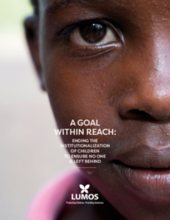This report from Lumos defines the global problem of institutionalization of children - including the factors that drive it and the harmful impacts it has on children's physical and cognitive development - and proposes global solutions in line with the Sustainable Development Goals. Featuring a variety of global thought leaders, the publication comprises twelve articles which tackle the major issues fueling institutionalization and how to achieve transformative change for affected children.
Chapters include:
- Children in Institutions: A Neglected Group in Monitoring the SDGs
- The Hazards of Institutional Rearing for Children’s Brain and Behavioral Development
- The Risk of Violence, Abuse, and Neglect to Children Living in Institutions
- Poverty as a Driver of Institutionalization
- Insufficient Access to Quality and Inclusive Education Throughout the Developing World: A Prime Driver for the ‘Institutionalization’ of Children with Disabilities
- Gender-Based Discrimination as a Driver for the Institutionalization of Children
- Ethnic Discrimination as a Driver of Institutionalization: Antigypsyism in Europe and Why Closing Institutions is not Enough
- Children and Forced Displacement: Marginalization and Parallel Systems as Drivers of Institutionalization
- Children and Armed Conflict: Children deprived of liberty and the damaging effects of institutionalization
- Trafficking as a Driver of Institutionalization
- Ensuring Safe and Sustainable Transformation of Care
- The Role of Faith-Based Groups in Transforming Care
The report also features testimonies from young people, including a youth advocate who outlines some of the ways in which children with disabilities can be prevented from entering institutions, and a young person in Haiti who discusses experiences with orphanage tourism. The report concludes with a Call to Action.

